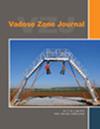Neutron imaging of exchange flow between biopore and matrix for Bt versus C horizons
IF 2.8
3区 地球科学
Q3 ENVIRONMENTAL SCIENCES
引用次数: 0
Abstract
The surface coating of biopores plays a pivotal role in mediating mass exchange between the biopore and the soil matrix, ultimately governing preferential flow in structured soils. However, quantitative experiments of the flow exchange dynamics in the soil around an earthworm burrow (drilosphere) are limited. Here, we developed an experimental setup to mimic preferential flow within a biopore while monitoring the water distribution by neutron radiography. The objective was to quantify the evolving water content distribution in the biopore with surrounding drilosphere samples from Bt and C horizons. We hypothesize that the distribution of clay and organic material across biopore surfaces in Bt and C horizons impacts the biopore coating material formation (i.e., composition and thickness), thereby influencing its role in controlling mass exchange during preferential flow events. The experimental setup was proposed for in situ quantification of the preferential flow dynamics in an earthworm burrow (biopore) passing through Bt and C horizons of a Luvisol developed on glacial till. The neutron radiographies were obtained at the NEUtron Transmission Radiography facility of the Paul Scherrer Institut, Villingen. The volumetric water content was quantified by calibrating gray scale values from radiography images with defined water contents using stepped aluminum cuvettes attached to the samples; image analysis was used to determine sorptivity at the biopore–soil matrix interface. The water exchange flow was found to be smaller for coated biopore surface in the more clayey Bt horizon, as compared to the coarser textured carbonaceous subsoil C horizon, where higher sorptivity intensified mass exchange. The method most realistically captured the dynamics of the vertical preferential flow process in a biopore, including lateral exchange flow, by determining the water sorptivity of the drilosphere. In contrast to mini‐infiltrometer data, biopore–matrix exchange flow was here more restricted for Bt in contrast to carbonaceous C horizon. Since both horizons showed the presence of coating material on their burrow walls, the results suggest further analysis of their contrasting properties and structures.对生物孔与基质之间的交换流进行中子成像,以了解 Bt 和 C 地层的情况
生物孔的表面涂层在介导生物孔与土壤基质之间的质量交换方面起着关键作用,最终控制着结构化土壤中的优先流动。然而,有关蚯蚓洞穴(钻孔层)周围土壤中流动交换动态的定量实验非常有限。在此,我们开发了一种实验装置,用于模拟生物孔内的优先流动,同时通过中子射线照相术监测水的分布。目的是量化生物孔内不断变化的含水量分布以及周围来自 Bt 和 C 层的钻孔层样本。我们假设,Bt 和 C 地层生物孔表面粘土和有机物的分布会影响生物孔涂层材料的形成(即成分和厚度),从而影响其在优先流动事件中控制质量交换的作用。该实验装置用于现场量化穿过冰碛物上发育的卢维索尔 Bt 和 C 地层的蚯蚓洞穴(生物孔)中的优先流动态。中子射线照片是在维林根保罗-舍勒研究所的 NEUtron 透射射线照相设备上获得的。通过使用附着在样品上的阶梯状铝制比色皿,将射线成像图像中的灰度值与定义的含水量进行校准,从而对体积含水量进行量化;图像分析用于确定生物孔隙-土壤基质界面的吸水率。结果发现,在粘质较多的 Bt 地层中,涂覆生物孔表面的水交换流量较小,而在质地较粗的碳质底土 C 地层中,较高的吸水率会加强质量交换。该方法通过测定钻孔层的吸水率,最真实地捕捉到了生物孔中垂直优先流动过程的动态,包括横向交换流。与微型浸润器数据相比,生物孔-基质交换流在 Bt 层比碳质 C 层受到更多限制。由于这两种地层的钻孔壁上都有涂层材料,因此研究结果建议进一步分析它们的不同性质和结构。
本文章由计算机程序翻译,如有差异,请以英文原文为准。
求助全文
约1分钟内获得全文
求助全文
来源期刊

Vadose Zone Journal
环境科学-环境科学
CiteScore
5.60
自引率
7.10%
发文量
61
审稿时长
3.8 months
期刊介绍:
Vadose Zone Journal is a unique publication outlet for interdisciplinary research and assessment of the vadose zone, the portion of the Critical Zone that comprises the Earth’s critical living surface down to groundwater. It is a peer-reviewed, international journal publishing reviews, original research, and special sections across a wide range of disciplines. Vadose Zone Journal reports fundamental and applied research from disciplinary and multidisciplinary investigations, including assessment and policy analyses, of the mostly unsaturated zone between the soil surface and the groundwater table. The goal is to disseminate information to facilitate science-based decision-making and sustainable management of the vadose zone. Examples of topic areas suitable for VZJ are variably saturated fluid flow, heat and solute transport in granular and fractured media, flow processes in the capillary fringe at or near the water table, water table management, regional and global climate change impacts on the vadose zone, carbon sequestration, design and performance of waste disposal facilities, long-term stewardship of contaminated sites in the vadose zone, biogeochemical transformation processes, microbial processes in shallow and deep formations, bioremediation, and the fate and transport of radionuclides, inorganic and organic chemicals, colloids, viruses, and microorganisms. Articles in VZJ also address yet-to-be-resolved issues, such as how to quantify heterogeneity of subsurface processes and properties, and how to couple physical, chemical, and biological processes across a range of spatial scales from the molecular to the global.
 求助内容:
求助内容: 应助结果提醒方式:
应助结果提醒方式:


